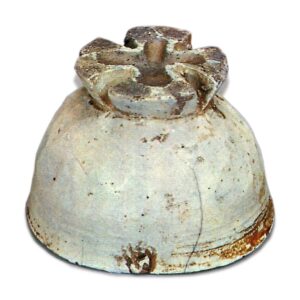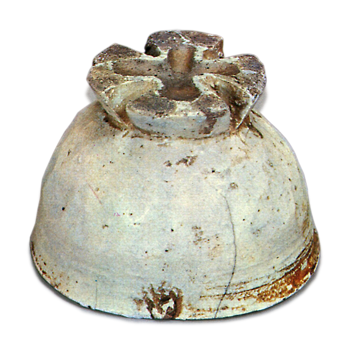
In the broad sense of the term, this refers to a part of the height of the plateau that has been broken off in one to three or four places. It is found not only in Korean tea bowls but also in Hagi, Yatsushiro, Satsuma, etc., and there are many imitations by later generations. In a narrow sense, it refers to a type of Korean tea bowls that came to Japan a long time ago. In the narrowest sense, wari-takadai refers to bowls in which the base is split in two places to form a V shape, while kiritakadai refers to bowls in which the base is split with a spatula and then cut into a slightly concave shape, i.e., the cut mark is in the shape of a U. Jumonji is a type of tea bowl in which the base is cut or broken into a ten-character shape all over the clay, and there are two types: kiritakadai jumonji and wari-takadai jumonji. The split height stand of Joseon tea bowls has been known as Koryogama since ancient times, and is generally thick and of the shape of a brush washing brush. It is said that the breaking of the tea bowls was done because it was convenient for stacking several bowls and hanging a rope when transporting them. The tea bowls with a high stand came to Japan when Lord Hideyoshi entered Korai, and became a specialty of Oribe Furuta’s. There are various ways of splitting the stand, and the skin of the medicine is all white, similar to a hard hand. There are not many wari-takadai. The reason why it has been highly respected since ancient times and regarded as an indispensable part of feudal lords’ tea bowls is probably due to Oribe’s recommendation. According to Imaizumiken’s theory, these bowls were imported from Korea in the Muromachi period (1336-1573), and were the outermost of a group of ten bowls stacked and bound with ropes, from which later generations of tea masters selected the most beautiful in appearance to make tea bowls, so that there are two types of tea bowls of the same type, one with a relatively high base and one without, with the best one placed at the outermost end. The best quality teacups are placed on the outer side of the bowls, so the ones with a high stand are the best among the same type, and are even more rare and valuable. The reason why they were so highly prized by tea masters is due to their age and the above reasons. In the “Manpo-Zensho,” there is an oral history of wari-takadai kaudaidai, which is described in the Kan’ei no teikan as follows: “It was made in the 245th year of the Kan’ei Era (1450) in the same era as the one before Idote, a solid handmade piece, made by rinsing a brush with the original brush, and costing 500 pieces, which is not the case in seven or eight other pieces under the sun, and because it is a rinsing brush, it has (missing characters) a trace where it was slipped off.



